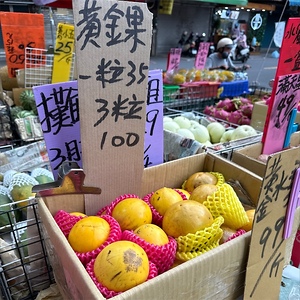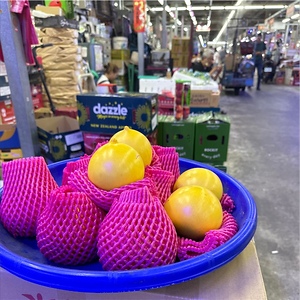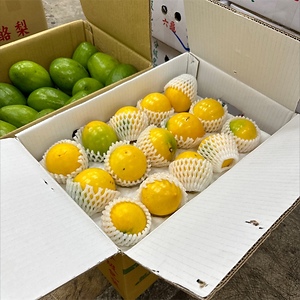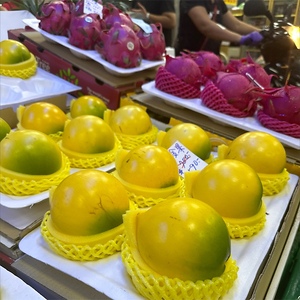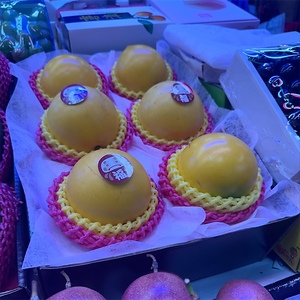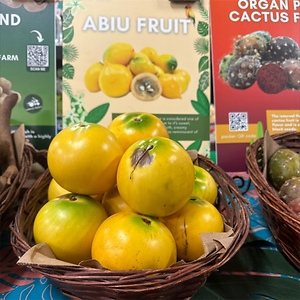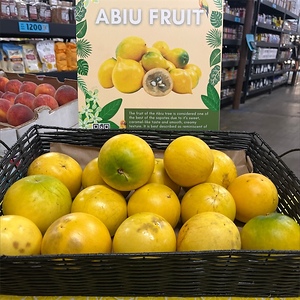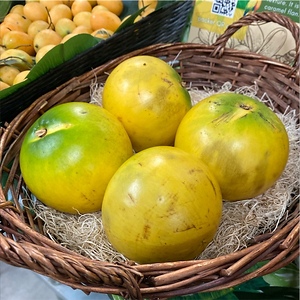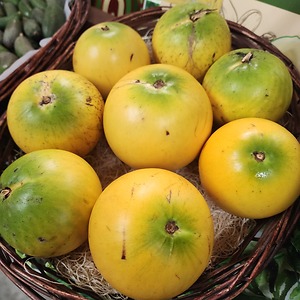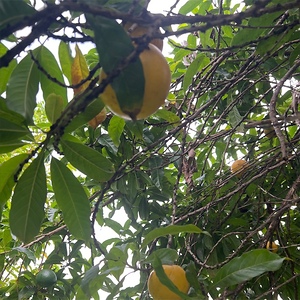


Abiu Fruit
Estimated Inventory, lb : 0
This item was last sold on : 06/22/24
Description/Taste
Abiu fruits are small in size, averaging 4 to 10 centimeters in length, and have a round to oval shape, sometimes showcasing a distinct nipple at the fruit’s apex, depending on the variety. The fruits typically range between 283 to 708 grams in weight and transition from shades of green, yellow-green, yellow, and dark golden yellow as they ripen. Some young Abiu fruits have a downy surface, and as they mature, the skin becomes smooth, taut, and faintly glossy. The skin is leathery and inedible but can be easily bruised and damaged if roughly handled. Underneath the skin, a layer of white, viscous, latex-like liquid resides between the flesh and skin. Younger fruits have a higher latex content, lessening as the fruits age. The pale, translucent clear to white flesh is aqueous, soft, and jelly-like with a melting, slippery, and succulent consistency. Depending on the variety, the flesh also contains 1 to 5 black-brown seeds. Abiu fruit is harvested when ripe or is picked once the fruits have shown a color break, transitioning from yellow-green to almost solid yellow. The fruits should only be eaten ripe and will have a soft give when gently squeezed combined with a yellow hue. Ripe Abiu fruits have a sweet, sugary taste with subtle nuances of caramel, maple syrup, vanilla, brown sugar, and custard. The fruits are also said to improve slightly in flavor when kept in storage for a few days.
Seasons/Availability
Abiu fruits are available at multiple points throughout the year, depending on the growing environment, region, and variety. The fruits generally have a peak season in the summer, and some varieties also produce crops in the winter.
Current Facts
Abiu, botanically classified as Pouteria caimito, is a tropical species belonging to the Sapotaceae family. The sweet fruits grow on evergreen trees reaching 9 to 12 meters in height and ripen around 3 to 4 months after flower pollination. Abiu fruits are native to the Amazon rainforest and are an ancient species utilized for centuries as a medicinal and culinary ingredient. In the 20th century, the fruits were collected, spread worldwide, and selectively bred to become a new possible commercial fruit. Abiu fruits are known by regional names worldwide, including Abieiro and Caimito in Brazil, Caimito in Colombia, Luma and Cauje in Ecuador, Temare in Venezuela, Yellow Sapote and Yellow Star Apple in Trinidad, and Wong Kum Kuo in Southeast Asia. Growers favor commercial Abiu varieties for their drought tolerance, heat resistance, productive nature, and low maintenance. The fruits have also been bred to have thicker skin for transportability, an extended shelf life, and improved flavoring. There are several varieties of commercial Abiu, including Gray Abiu, Z1, Z2, Z3, Z4, T31, T25, Brunello, Cape Oasis, and Inca Gold. Abiu fruits are still relatively unknown in commercial markets, but production is expanding as specialty growers advocate for sweet, juicy, and melting fruits. Consumers favor abiu fruits for their rich, distinct flavor, and the fruits are consumed as a delicacy in select fresh and cooked preparations.
Nutritional Value
Abiu fruit is a source of vitamin A to maintain healthy organ functioning, vitamin C to strengthen the immune system, and fiber to regulate the digestive tract. The fruits also provide calcium to build bones and teeth, potassium to balance fluid levels within the body, iron to develop the protein hemoglobin for oxygen transport through the bloodstream, and other nutrients, including B vitamins, phosphorus, niacin, and thiamine. In Brazil, Abiu fruits are prized for their mucilaginous nature and are consumed to soothe coughs and sore throats. The latex-like liquid from the fruit is also applied topically to skin issues and sores.
Applications
Abiu fruit has a sweet and subtle, caramel-like flavor suited for fresh and cooked preparations. The species is most popularly consumed straight out of hand once ripe and can be served at room temperature or slightly chilled. A squeeze of lemon or lime juice is also sprinkled over the flesh for enhanced flavoring. Abiu fruits are traditionally sliced in half, and the flesh is scooped with a spoon. It is important to note that the flesh browns quickly once exposed to air, so the fruits should be immediately consumed after opening. Abiu fruits can also be sliced and added to salads, used as a topping over yogurt, or served with other fresh fruits as a breakfast side. Other flavors can easily overpower the fruit’s subtle flavoring. It is recommended to pair the fruits with other delicate-flavored ingredients. In addition to eating fresh, Abiu fruits are incorporated into jams, ice cream, and sherbert or blended into smoothies and milkshakes with coconut water as a refreshing treat. The fruits are also occasionally used in cakes, tarts, pannacotta, pudding, and cheesecakes. Try drying Abiu fruits or slicing them in half and caramelizing them with a blowtorch to create a natural variation of crème brulé. Abiu fruit pairs well with vanilla, citrus, papaya, pineapple, and coconut. Whole, unopened Abiu fruit should be kept at room temperature until ripe. The fruits will continue to ripen at room temperature and can last for 5 to 14 days. Some varieties may last longer, up to one month. The fruits can be stored in the refrigerator, but the skin may darken in the cold. Despite this darkening, the flesh is still edible and is solely an aesthetic preference.
Ethnic/Cultural Info
Abiu fruits have been grown in home gardens of communities throughout the Amazon, especially among the indigenous people group of Assunção do Içana in the territory of Alto Rio Negro, Brazil. The fruits have been traditionally used as a culinary and medicinal ingredient, but the sticky latex-like sap is also extracted from the fruit as a natural glue. When consuming the fruit, the sap is avoided, and Amazonian communities historically greased their lips before eating the fruits to prevent the latex from sticking their lips together. Outside of eating, the glue-like sap was used for cuts, sealing containers, and as a tool to make materials bond together. Wood from the Abiu tree has also been used as a construction material, prized for its dense, hard nature. Despite their presence in the Amazon for centuries, wild populations of Abiu have recently decreased due to deforestation. Efforts are being made by family-owned properties to protect and preserve populations of Abiu in the Amazon, and the species is being grown in agroforestry orchards.
Geography/History
Abiu fruit is native to South America, and wild species have been naturally found in the Amazon since ancient times. The center of diversity is thought to be in a region between the meeting of the Napo and Ica Rivers in the Amazon and has also been hypothesized to grow wild along the lower eastern slopes of the Andes Mountains in Venezuela and Peru. Throughout South America, Abiu fruit was taken from the wild and grown on a small scale in the home gardens of indigenous communities. Over time, the species was spread into Central America and was introduced to the United States through the efforts of plant explorers Popenoe, Dorsett, and Shamel, with the Department of Agriculture in 1914. Abiu fruits were also re-introduced into the United States several other times in 1915, 1944, and 1953 and were planted in Southern Florida. In the United States, Abiu fruits struggled in Florida due to periodic freezes, but the species thrived in Hawaii. Abiu fruits were also introduced to Australia beginning in the 1950s and were planted in the 1970s and 1980s. The species was bred among growers in Queensland and the Northern Territory. The Zappala family in Queensland has notably bred and propagated several successful varieties grown throughout Australia. Abiu fruits are commercially grown on a small scale in Australia, and varieties grown on the continent are improved varieties of the originally wild versions found in the Amazon. Outside of Australia and the United States, Abiu has been planted throughout Southeast Asia and is being commercially trialed for possible expansion. Today, Abiu fruits thrive in tropical to warm, subtropical climates and grow in deep, well-draining soils in full sun. The fruits are increasing in notoriety, but they are still a relatively unknown species in commercial markets. When in season, Abiu fruits are sold fresh through local markets and specialty retailers in South America, mainly in Brazil, Venezuela, Peru, Colombia, and Ecuador, Australia, Southeast Asia, the Caribbean, Latin America, and the United States.



